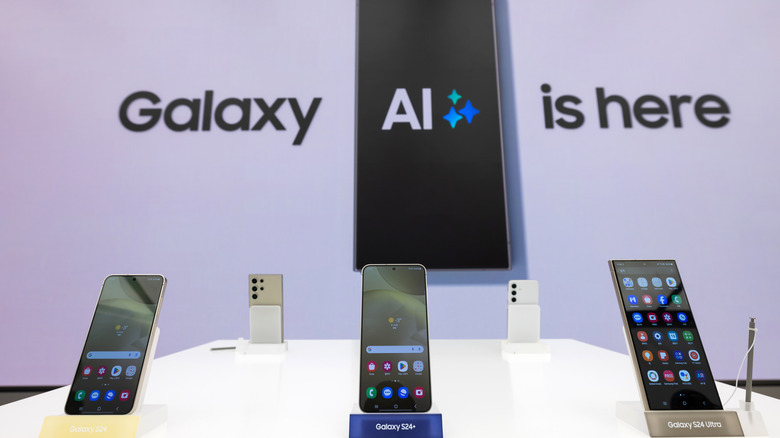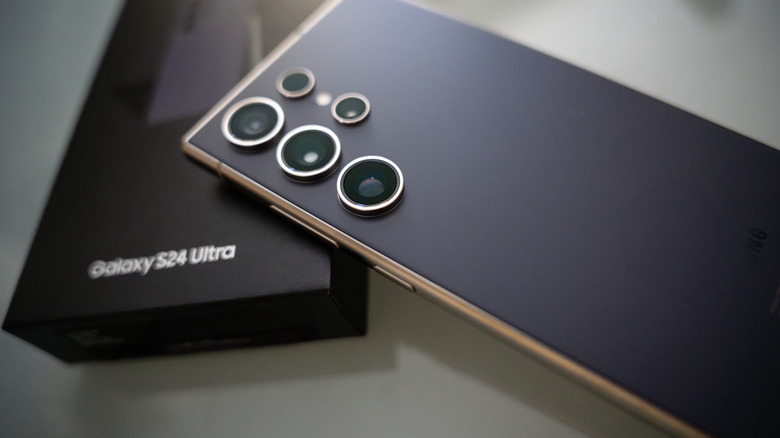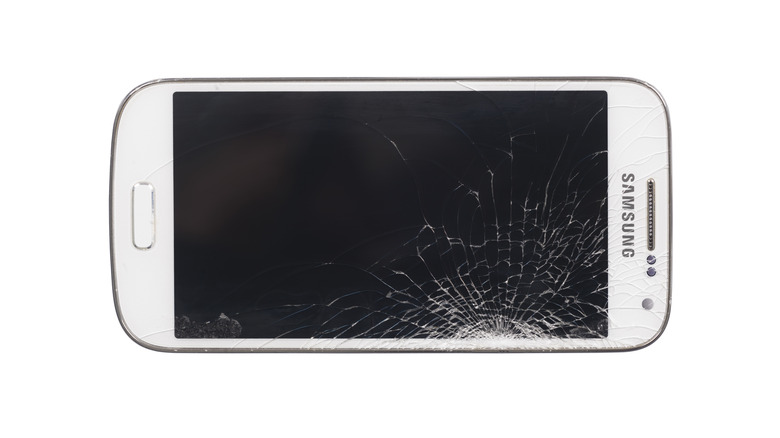
Bloomberg/Getty Images
If you’re in the market for a new smartphone, then trading in your old one is a tried and true way to save money on your purchase. Exactly how much value you will get for your old handset depends on several factors, including whether you’re trading for credit towards a new device or cold hard cash, the condition of the device, and if your carrier has any special trade-in promotions. There are also various steps needed to prep the device once you’re done with it, like backing up your personal data, logging it out of your accounts, wiping it clean with a factory reset, and packing it securely if the trade-in is a remote one.
Samsung, in particular, has some attractive trade-in deals for its new flagships, with the postpaid mobile carriers offering similar deals when the various Galaxy phones are brand new, including for the recently-released Galaxy S24 series. So if you’re a Samsung loyalist looking to trade in your old device for an upgrade, read on to learn everything that you need to do so as to get the most out of your trade-in.
Private sales are usually your best bet

Alacatr/Getty Images
To the average person looking to upgrade their phone, offloading their existing handset through a trade-in service is presumed to be the default. It’s the highest profile solution with the least friction and where you’re more or less guaranteed to get paid something. However, it’s generally not going to get you anything close to the highest resale value.
For example, look at the Galaxy S22, which is turning two years old right around when this article was written. Owners on payment plans who purchased at launch are probably about to pay their devices off, so they may be considering getting something new. But the S22, which was $799.99 (for 128GB storage) or $849.99 (for 256GB storage) at retail when it launched, will generally fetch you well under $200.00 on a traditional trade-in platform.
As of this writing, the popular trade-in site Gazelle.com offers $173.00 for a 256GB S22 in good condition, while T-Mobile offers a $145.00 estimate and AT&T offers $150.00. Best Buy, somewhat surprisingly (as a massive chain with massive overhead) offered a more generous $210.00, slightly more than BackMarket’s $205.00, while kiosk-based trade-in broker ecoATM offered a paltry $110.00. That’s a lot of depreciation in two years, especially at a time when year-over-year improvements are minimal.
Looking at completed eBay listings shows the value of a direct sale over a guaranteed trade-in: Listings for working 256GB S22s have often sold at $250.00 or more, sometimes getting as high as $400.00. There’s a higher upside, but you have to do all of the work and eat a 12.55% fee.
There are often trade-in bonuses towards brand new flagship models

Javi_indy/Getty Images
Samsung and some mobile carriers often offer trade-in bonuses that give you more credit for your existing handset than you would get through the trade-in process otherwise. With carrier offers, this sometimes includes adding a line or changing your plan as part of the deal, but it can still result in the best deal some of the time.
Using the aforementioned Galaxy S22 as an example to trade-in towards a Galaxy S24, T-Mobile’s bonuses start at a slight bump to $200.00 trade-in value regardless of what rate plan you’re on. If you’re on a «qualifying Go5G,» — the base Go5G — «ONE or Magenta rate plan,» then that enhanced trade-in value bumps up to $500.00. And if you’re on the Go5G Plus or Go5G Next plan? That trade-in will get you up to $1,000.00 in credit, with the «up to» caveat being that you get a free phone if the S24 model is one, like the base model, that goes for under $1,000.00. These deals vary depending on what you’re trading in towards, with the iPhone 15, for example, having a floor of $300.00 and a ceiling of $830.00 for the trade-in credit.
Samsung.com’s trade-in calculator, meanwhile, offers $450.00 credit for an S22 being traded in towards an S24, while Verizon offers «up to $800.00» with a new line and AT&T offers $800.00 if on an «eligible unlimited plan.» If your timing is right, these kinds of trade-ins are your best choice.
Be honest about the condition of your phone

Basar17/Getty Images
This should be common sense, but it still deserves to be talked about: When you do a trade-in, you need to be as honest about the condition of your phone as you can be, lest you get a counter-offer of less cash or credit than the quote that you initially received. Using Gazelle for the aforementioned Galaxy S22 trade-in, there are three criteria: That the phone is fully functional, both sides of the phone are «free of cracks,» and the «overall cosmetic condition.» That last one is broken down into four grades: «Flawless or like new,» «Lightly used,» «Scratched or scuffed,» and «Damaged or broken.»
Dropping the «overall cosmetic condition» rating down to «Lightly used» drops the value $16.00, from $173.00 to $157.00. Going down to «Scratched or scuffed» is a $32.00 drop to $141.00, while «Damaged or broken» — in this case, damage that isn’t a crack that doesn’t keep the phone from functioning properly — drops you $57.00 to $116.00. Answering «no» to any or all of the first three questions, meanwhile, drops you down $98.00 to $75.00.
Again: Just be honest, and if your phone is truly busted, trying to sell it on eBay «as-is»https://www.slashgear.com/»for parts» might be the best move, but those sale prices can vary wildly.
Make sure that you’re backing up your data to the cloud

Thx4Stock team/Shutterstock
Making sure that you transferred everything over from your old phone has gotten a lot easier over the years. These days, most of the key data is backed up to the cloud, and if you have a Samsung phone, then you have cloud backup to both Google Drive/Google One and Samsung Cloud baked into the operating system. You can then restore from the Google backup on any Android phone and the Samsung backup on any Galaxy handset.
To make sure that you’re backed up to Google Drive on a phone you’re getting ready to wipe and send out:
- Open the Google One app.
- Tap Storage at the bottom of the screen.
- Scroll down to the Device Backup heading. If this is your first time, then tap Set up data backup. If it’s not? Tap View details.
- If you need to tweak the listed backup settings, tap Manage backup. When you’re done, back out to the previous page.
- Tap Back up now.
Using Samsung Cloud:
- Open the Settings app.
- Scroll down to and tap Accounts and Backup.
- Tap Back up data under the Samsung Cloud heading.
- Choose what you want to be backed up by flicking the relevant toggle switches on or off.
- Tap Back up now.
That’s it! Now you can restore entirely from a cloud backup.
Factory reset the phone to wipe it clean
Once you know for sure you’re done with a phone and have backed up its data, you need to wipe it clean before you trade it in. To wipe a Samsung Galaxy phone, you need to do a factory reset. The process is pretty simple, but first, you should sign out of your Google and Samsung accounts to unlink the handset from both of their device-finding services:
- Open the Settings app.
- Scroll down to and tap Accounts and backup.
- Tap Manage accounts.
- Tap your Google or Samsung account.
- Tap Remove account.
- Repeat with whichever account you didn’t delete the first time.
To do the factory reset:
- Open the Settings app.
- Tap General management.
- Scroll down to and tap Reset.
- Tap Factory data reset and heed the resulting warning.
- Tap Reset.
- Enter your lock screen code if you have one.
- Tap Delete all.
- If you have a Samsung account, you need to enter that password, as well.
All done! Your phone is read to send in.
Find the right packaging if it’s a remote trade-in
One complicating factor is that most of the methods being discussed here involve shipping the phone. Smartphones are delicate, especially the glass on the front that covers the display (and, less commonly, the rear shell of the phone), so mailing them requires particular care.
If you still have the original manufacturer’s packaging with all of the inserts, that’s a great place to start. You’d want to put it in additional packaging for shipping, but having a box that’s perfectly fitted for the phone will go a long way in keeping it from moving around. A padded envelope is likely enough additional protection for shipping to put around a phone tightly packed in its original box. Putting that manufacturer’s box inside a more shipping-suitable box with some padding around it is probably even better, though.
If you don’t have that original box, then a purpose-built smartphone shipping box — which some trade-in companies provide — is going to be the safest bet. Generally speaking, these are going to include cardboard inserts that help isolate and protect the phone and/or a pouch that keeps the phone away from the sides of the box.
Absent something more purpose-built? You simply want as much padding as possible:
- Pad the bottom of the box with packing materials like bubble wrap, packing peanuts, or packing paper.
- Wrap the phone in bubble wrap or put it in a bubble wrap pouch, then put it in the box.
- Fill the rest of the box with more padding.
- Seal the box.
Whatever do you, just make sure the phone is secure.